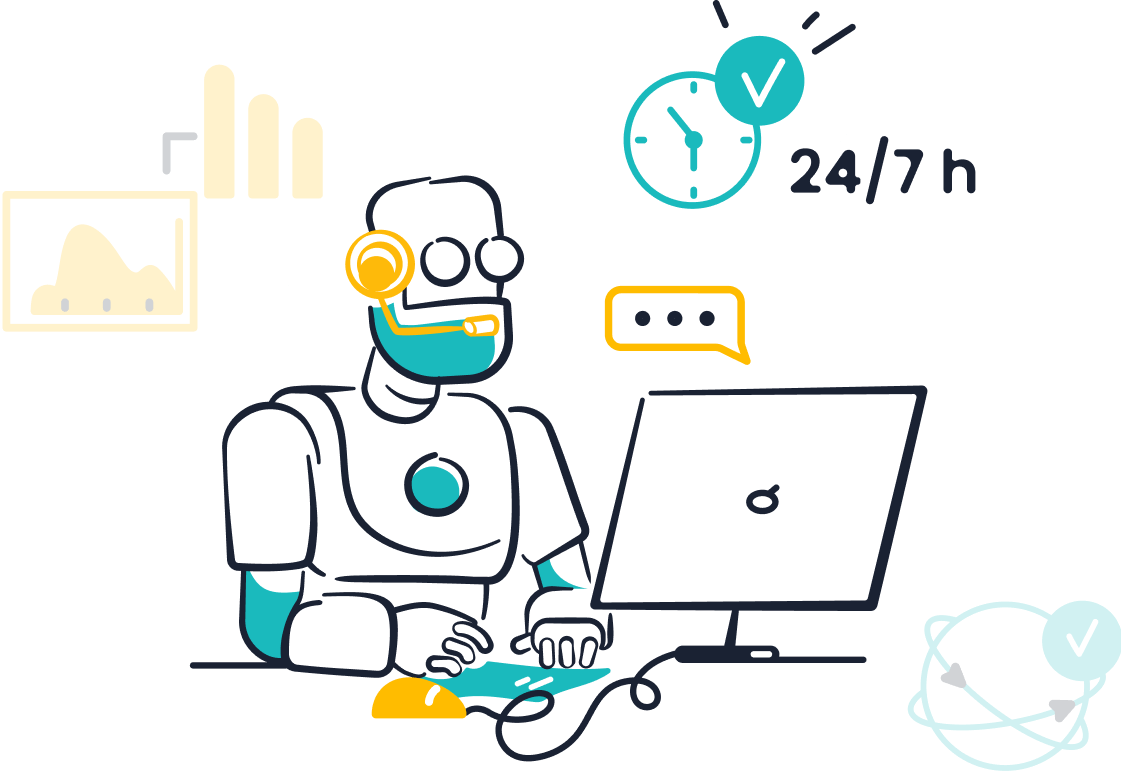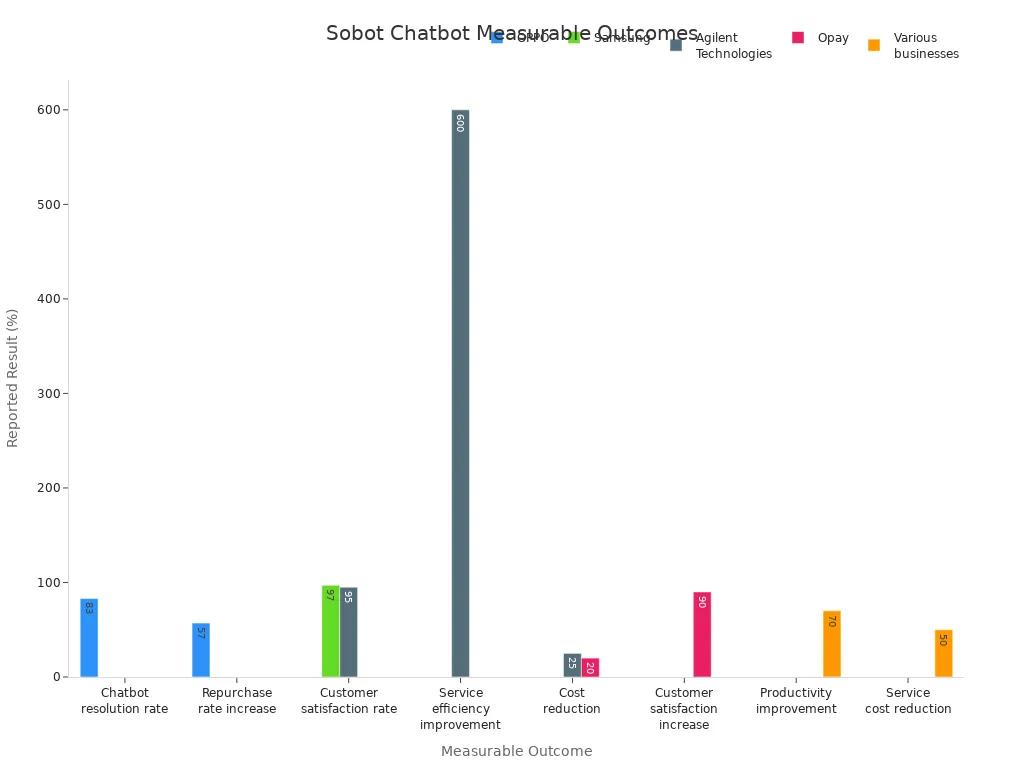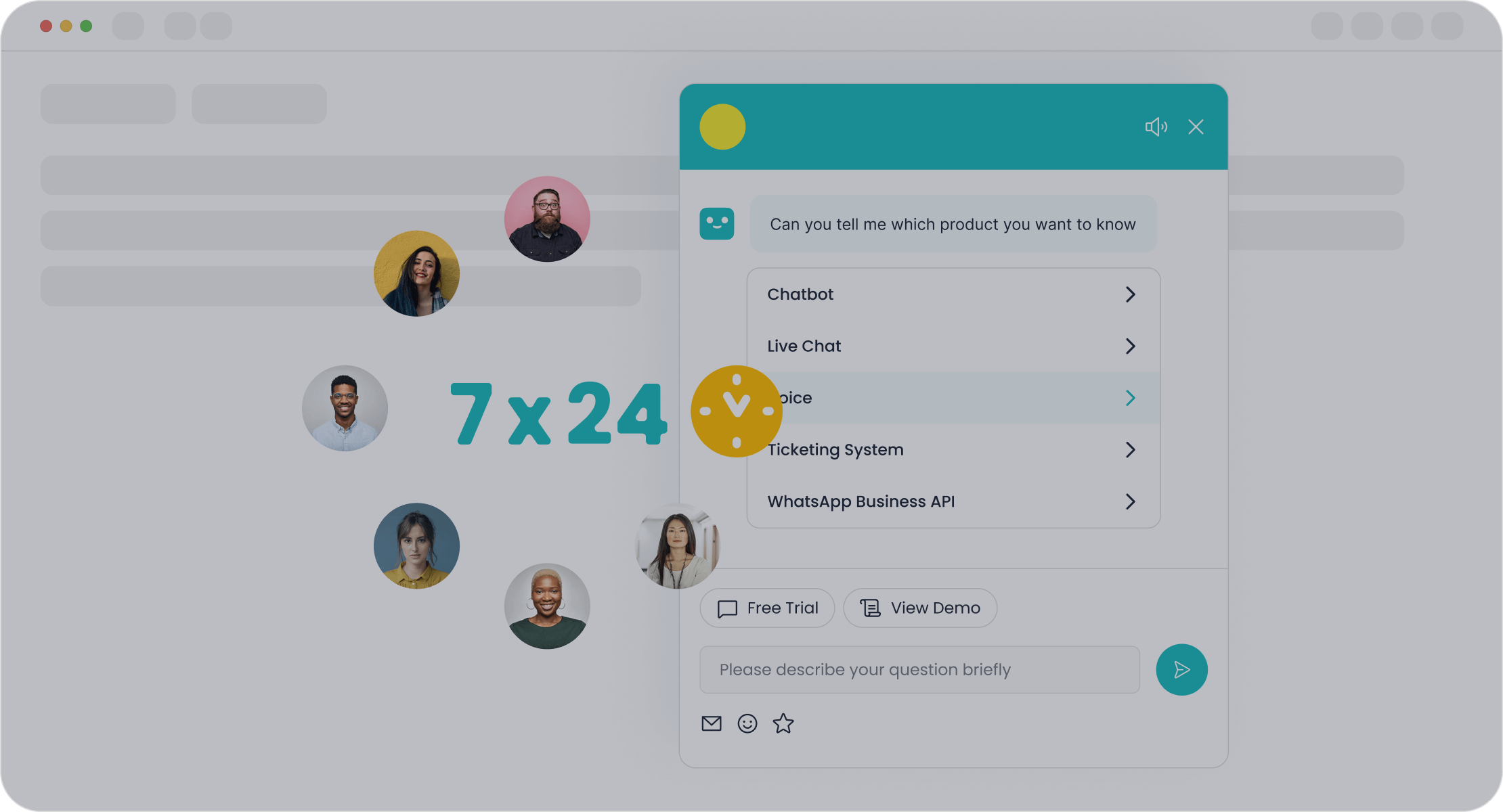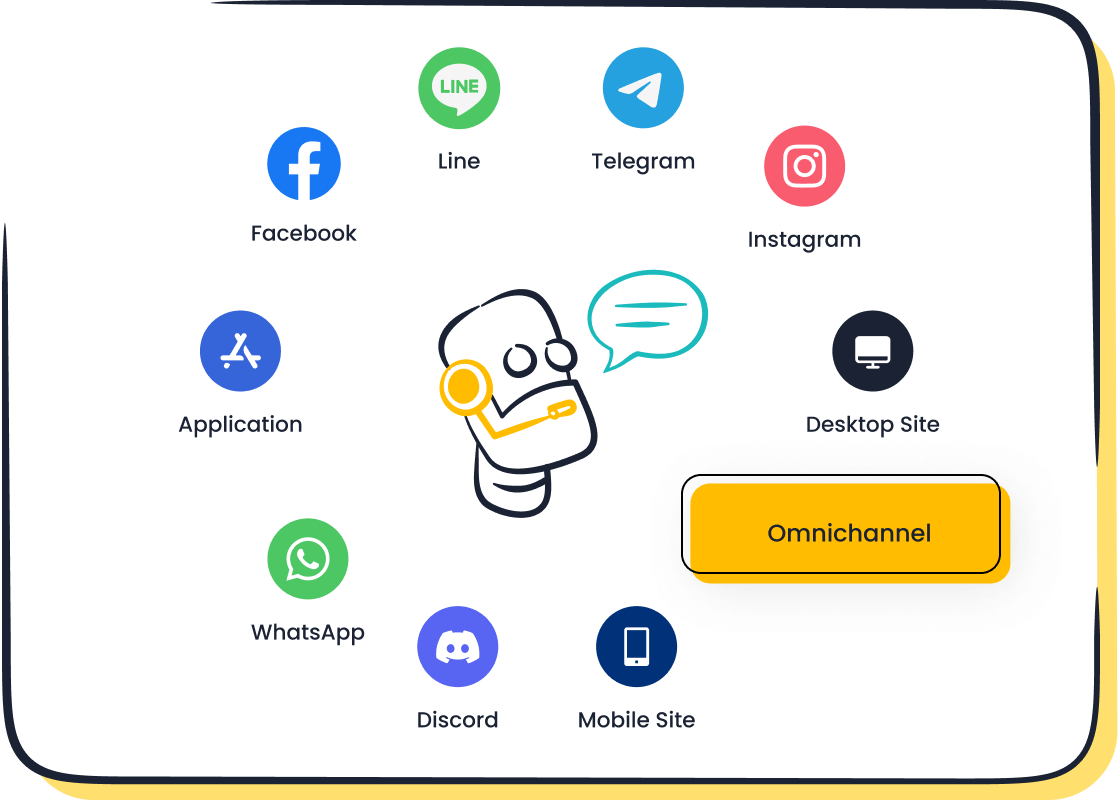Key Chatbot Metrics to Measure Performance Effectively

To effectively measure performance and enhance customer experience, tracking the right chatbot metrics is essential. Key performance indicators such as engagement, retention, response time, resolution rate, self-service rate, bounce rate, message click-through, goal completion, accuracy, and customer satisfaction provide valuable insights into your chatbot’s effectiveness. With Sobot AI, you gain access to real-time analytics that simplify monitoring these metrics, enabling you to achieve impressive results like OPPO’s 83% chatbot resolution rate and a 57% boost in repurchase rates. Integrating these insights with the Sobot call center further optimizes your customer service operations for maximum efficiency and satisfaction.

Engagement Metrics

Understanding engagement metrics helps you see how well your chatbot connects with users. These metrics show if people find your chatbot helpful and if they want to keep using it. In customer service and e-commerce, high engagement means your chatbot is meeting user needs and making their experience better.
Engagement metrics help you measure how often users interact with your chatbot and how meaningful those interactions are. When you track these numbers, you can spot trends and make changes that improve your chatbot’s performance.
Here is a table that shows how different engagement metrics relate to chatbot effectiveness:
| Engagement Metric | Correlation with Chatbot Effectiveness | How to Track / Measure |
|---|---|---|
| Engagement Rate | Higher rates show better user attraction and chatbot relevance. | Number of interactions per unique visitor using analytics tools. |
| Conversation Length | Shorter conversations may mean quick solutions; longer ones may show complex issues. | Average number of messages per conversation using chatbot analytics. |
| Resolution Rate | High rates show the chatbot meets user needs and solves problems. | Ratio of resolved interactions to total interactions. |
| Customer Satisfaction (CSAT) Score | Direct measure of user satisfaction with chatbot interactions. | Post-interaction user ratings collected through feedback tools. |
| Conversion Rate | Shows how well the chatbot drives sales or actions. | Percentage of users completing actions like purchases. |
| Drop-off Rate | High rates may show problems in chatbot flow or response quality. | Analysis of where users leave conversations. |
| Response Time | Faster responses lead to better user experience and satisfaction. | Average time for chatbot replies, available in analytics dashboards. |
User Engagement Rate
User engagement rate tells you how many users interact with your chatbot compared to the total number of visitors. A high user engagement rate means your chatbot attracts attention and encourages people to start conversations. This metric is important because it shows if your chatbot is visible and interesting to your audience.

Sobot Chatbot helps you boost user engagement rate by supporting many channels like websites, social media, and messaging apps. You can reach users where they feel most comfortable. Sobot’s multilingual support lets you connect with people in their preferred language, which increases engagement. Studies show that multilingual chatbots make users more likely to interact and stay engaged.
Total Interactions
Total interactions count every message exchanged between users and your chatbot. This number helps you understand how active your chatbot is and how much value it provides. More interactions often mean your chatbot is useful and users rely on it for answers.
You can use Sobot’s analytics dashboard to track total interactions across all channels. This helps you see which platforms drive the most activity. When you notice a rise in total interactions, you know your chatbot is becoming a bigger part of your customer service or e-commerce strategy.
- Consumers want to use different channels like email, chat, and social media. Omnichannel chatbots, like Sobot, meet this need and increase engagement.
- Multilingual chatbots help users feel understood, which leads to higher engagement rates.
- Companies that use omnichannel and multilingual chatbots see better customer satisfaction and loyalty.
Tracking engagement metrics like user engagement rate and total interactions helps you make smart decisions. You can improve your chatbot and give users a better experience every time they connect.
Retention Metrics
Retention metrics help you understand how well your chatbot keeps users coming back over time. When you track these numbers, you see if your chatbot builds loyalty and encourages repeat visits. High retention means users find value and trust your chatbot for ongoing support or shopping.
Retention metrics show you which features users like and which ones need improvement. You can use this information to make your chatbot more helpful and engaging.
Session Frequency
Session frequency measures how often users start conversations with your chatbot. If users return often, your chatbot provides real value. In e-commerce, frequent sessions mean customers rely on your chatbot for quick answers and support. Most industries aim for 10% to 30% active user sessions. E-commerce companies often reach the higher end because shoppers need help with orders, returns, and product questions.
Here is a table showing industry benchmarks for session frequency and retention:
| Metric | Definition | Industry Benchmark Range | Example/Notes |
|---|---|---|---|
| Chatbot Engagement Rate | Measures frequency of user interactions and session duration | 10% to 30% active user sessions | Higher in sectors like e-commerce due to frequent interactions |
| Customer Retention Rate | Percentage of returning users over a period | Above 70% | Example: 75% retention if 75 out of 100 clients return in a month |
Sobot’s reporting features let you track session frequency across all channels. You can see which times and platforms drive the most activity. This helps you adjust your chatbot strategy to boost engagement.
Active Users
Active users are people who interact with your chatbot within a set time, such as a week or month. Tracking active users shows you how many people rely on your chatbot for help or information. If you see a steady or growing number, your chatbot is meeting user needs.
Sobot’s analytics dashboard gives you real-time data on active users. You can spot trends and see which features attract the most attention. The dashboard also helps you compare chatbot metrics with traditional support channels. Faster responses and higher satisfaction scores lead to better retention.
You can improve retention by:
- Identifying key user engagement events with reporting tools.
- Analyzing feature usage and satisfaction scores.
- Using insights to fix pain points and improve chatbot flows.
- Offering personalized onboarding and proactive support.
Sobot’s reporting features help you monitor these metrics and make smart changes. When you use these insights, you create a chatbot that users want to return to again and again.
Response and Resolution
Fast response and quick problem resolution are two of the most important factors for customer satisfaction. When you use a chatbot, you want answers right away. Customers expect instant help, and slow replies can lead to frustration or lost sales.
Response Time
Response time measures how quickly your chatbot replies to users. A fast response shows that your business values the customer’s time. In leading customer service applications, chatbots have reduced average response times by about 70%. Before AI chatbots, customers waited over three minutes for a reply. Now, most chatbots respond in under one second.
| Metric | Before AI Chatbot | After AI Chatbot | Improvement (%) |
|---|---|---|---|
| Average Response Time | 3.2 minutes | 0.9 seconds | 72% reduction |
You can see how much faster a chatbot can be compared to traditional support. Sobot Chatbot takes this even further. With 24/7 availability and omnichannel support, Sobot ensures your customers get help any time, on any platform. This level of speed and access builds trust and keeps users coming back.
- AI chatbots reduce average response times by 37% in high-volume industries.
- Omnichannel support means your chatbot meets customers wherever they are.
First Contact Resolution
First contact resolution (FCR) shows how often your chatbot solves a problem on the first try. High FCR means fewer follow-ups and happier customers. AI-powered chatbots automate up to 80% of inbound questions, letting human agents focus on complex issues. This boosts FCR by up to 30%.
Sobot Chatbot uses AI to understand intent and guide users to the right answers. With 24/7 service, your customers get instant help, even during busy times. For example, a telecom company increased its FCR from 65% to 82% after adding AI chatbots, while also cutting wait times by 40%. Sobot’s AI-driven efficiency helps you achieve similar results, improving both customer satisfaction and loyalty.
Containment Rate
Containment rate tells you how many user questions your chatbot solves without needing help from a human agent. You can measure containment rate by dividing the number of queries handled by the chatbot by the total number of queries received, then multiplying by 100. A high containment rate means your chatbot answers most questions on its own. This shows strong chatbot effectiveness and saves time for your support team.
Containment rate = (Number of queries handled by chatbot / Total queries received) × 100
Sobot’s AI-powered chatbot uses smart automation and a rich knowledge base to resolve common questions. You can track containment rate using Sobot’s analytics dashboard. This helps you see how well your chatbot supports customers across channels like chat, email, and social media.
Escalation Rate
Escalation rate measures how often your chatbot sends questions to a human agent. You calculate escalation rate by dividing the number of escalated queries by the total number of interactions. A low escalation rate means your chatbot handles most issues independently. If the escalation rate is high, you may need to improve your chatbot’s knowledge base or training.
Escalation rate = (Number of queries escalated to human agents / Total interactions) × 100
Sobot’s chatbot reduces escalation by using AI to understand customer intent and provide accurate answers. You can monitor escalation rate in real time and adjust your chatbot’s responses to improve chatbot effectiveness.
Chatbot Effectiveness
You can see the impact of high containment and low escalation rates in real-world results. OPPO, a global smart device brand, used Sobot’s chatbot to handle a surge in customer inquiries. The chatbot achieved an 83% resolution rate, meaning it solved most questions without human help. OPPO also saw a 94% positive feedback score and a 57% increase in repurchase rates.
| Metric | Value |
|---|---|
| Chatbot Resolution Rate | 83% |
| Positive Feedback Score | 94% |
| Increase in Repurchase Rates | 57% |
These numbers show how a well-trained chatbot can boost customer satisfaction and loyalty. You can use Sobot’s reporting tools to track these metrics and improve chatbot effectiveness for your business.
Satisfaction Metrics
Measuring satisfaction metrics helps you understand how well your chatbot meets user needs. These metrics show if users feel happy after interacting with your chatbot. They also help you see if your chatbot improves the overall customer experience. Two of the most important satisfaction metrics are CSAT score and NPS.
CSAT Score
CSAT, or Customer Satisfaction Score, tells you how satisfied users feel after a chatbot conversation. You can measure CSAT in a few standard ways:
-
- Collect user ratings on a scale, such as 1 to 5.
- Count the number of positive ratings (usually 4 and 5).
- Divide by the total number of ratings.
- Multiply by 100 to get a percentage.
-
Composite Average Method
- Add up all the ratings.
- Divide by the number of responses to get the average user satisfaction score.
Most chatbots, including Sobot, ask users for feedback right after a chat. You might see a quick survey with numbers or emojis. This makes it easy for users to share their feelings. A high user satisfaction score means your chatbot gives clear answers and solves problems quickly. Sobot’s analytics dashboard lets you track these scores in real time, so you can spot trends and make improvements.
NPS and Feedback
NPS, or Net Promoter Score, measures how likely users are to recommend your brand after using your chatbot. While CSAT focuses on single interactions, NPS looks at overall loyalty. If your chatbot delivers a great customer experience, your NPS will rise.
You can collect and analyze feedback in several ways:
- Use real-time surveys after each chatbot session.
- Design smart surveys with AI to ask the right questions.
- Gather feedback across websites, social media, and messaging apps.
- Send follow-up messages to keep users engaged.
- Offer multilingual surveys to reach more users.
Sobot makes feedback collection simple. The platform uses AI to design surveys, collect responses, and generate reports. You can see which parts of your chatbot work well and which need improvement. By tracking user satisfaction score and NPS, you can boost customer experience and build stronger loyalty.
Conversion Metrics
Conversion metrics help you see how your chatbot drives sales and captures leads. These numbers show if your chatbot turns conversations into real business results. In e-commerce and customer service, tracking conversion rate and goal completion rate gives you a clear picture of your chatbot’s impact.
Conversion Rate
Conversion rate measures how many users take a desired action after interacting with your chatbot. This action could be making a purchase, signing up for a newsletter, or requesting a demo. A high conversion rate means your chatbot guides users well and helps them reach their goals.
Here is a table showing average conversion rates for chatbots in different industries:
| Scenario | Conversion Rate / Result | Source / Example |
|---|---|---|
| E-commerce general | Over 20% revenue growth from AI chatbots | Fastbots.ai blog |
| E-commerce retail | 15% sales increase (H&M) | Hellotars blog |
| E-commerce retail | Up to 40% sales growth | Omind.ai blog |
| Grocery | 12-18% basket size increase | Grocery Doppio interview |
| Lead generation | 40% lead base growth (KLM Airlines) | Botscrew blog |
| Travel | 23% conversion rate improvement | Botscrew blog |
On average, customers who interact with a chatbot are three times more likely to complete a purchase than those who do not. This shows the power of a well-designed chatbot in boosting your conversion rate.
Sobot Chatbot uses proactive messaging and real-time intent assistance to guide users through the buying process. For example, if a customer lingers on a product page, Sobot can send a helpful message or offer a discount. This approach reduces cart abandonment and increases the chance of a sale.
Goal Completion
Goal completion rate tells you how often your chatbot helps users finish important tasks. These tasks might include completing a purchase, booking an appointment, or filling out a form. Tracking this rate helps you see if your chatbot meets user needs and supports your business goals.
Proactive messaging and real-time intent assistance play a big role in improving goal completion rate. Here is how these features work:
- Proactive chatbots start conversations when users seem stuck or inactive.
- Real-time intent assistance predicts what users want and offers suggestions.
- Timely nudges help users finish purchases or sign-ups.
- Personalized messages make users feel understood and supported.
- Proactive chatbots guide users step by step, making tasks easier to complete.
Sobot Chatbot uses these features to boost both conversion rate and goal completion rate. You can track these metrics in Sobot’s analytics dashboard and adjust your chatbot’s flow for better results. Monitoring these numbers helps you spot trends and make smart changes that drive more sales and leads.
Error and Accuracy
Error and accuracy are important chatbot performance metrics. These numbers show how well your chatbot understands questions and gives correct answers. When you track error rate and accuracy metrics, you can see if your chatbot helps users or causes confusion.
Error Rate
Error rate measures how often your chatbot gives wrong answers or fails to understand a user’s request. You want this number to be low. A high error rate means users get frustrated and may leave without solving their problems. You can calculate error rate by dividing the number of incorrect or failed responses by the total number of chatbot interactions.
Tip: Track error rate every week to spot problems early and fix them fast.
Sobot’s AI chatbot uses smart training and a strong knowledge base to keep error rates low. The system learns from real user questions and updates its training data often. This helps the chatbot handle new topics and changing customer needs. Sobot also uses feedback from users and experts to correct mistakes and fill knowledge gaps.
Here are ways Sobot reduces errors:
- Uses accurate and up-to-date training data.
- Updates knowledge base with real user queries.
- Flags confusing or contradictory answers for review.
- Analyzes low-confidence responses to find gaps.
- Tracks error rates and escalation rates for improvement.
Accuracy Metrics
Accuracy metrics show how often your chatbot gives the right answer. High accuracy means users get helpful replies and finish their tasks. You can measure accuracy by looking at the percentage of correct responses out of all chatbot interactions.
| Metric | What It Shows | How to Improve |
|---|---|---|
| Error Rate | Frequency of mistakes | Update training data, review feedback |
| Accuracy Rate | Correct answers given | Optimize knowledge base, use expert reviews |
Sobot’s chatbot uses advanced AI models to understand user intent and context. The system collects feedback and reviews answers to keep improving. Regular updates and expert checks help the chatbot stay accurate as products and customer needs change.
Tracking chatbot performance metrics like error rate and accuracy helps you build trust and improve user experience. Sobot’s reporting tools make it easy to monitor these numbers and optimize your chatbot for better results.
Cost Efficiency
Understanding cost efficiency helps you see the real value a chatbot brings to your business. You want to know how much each conversation costs and how much money you save or earn by using a chatbot. These numbers show if your investment in automation pays off.
Cost per Conversation
Cost per conversation tells you how much you spend every time a customer interacts with your chatbot. In enterprise settings, this cost usually falls between $1 and $2 after you set up the system. This number includes platform fees, the number of conversations, and how well your chatbot solves problems without needing a human agent. For example, a fashion retailer saved $1.1 million in one year by using a chatbot, while also reaching a 92% member satisfaction rate. These savings come from automating routine questions and reducing the need for extra staff.
Sobot Chatbot helps you lower your cost per conversation by handling up to 80% of common support requests automatically. You can scale your support without hiring more agents. Sobot’s 24/7 availability means you never miss a customer, even outside business hours. This efficiency lets you serve more people at a lower cost.
Tip: Track your cost per conversation monthly. If the number drops, your chatbot is working well.
ROI of Chatbot
ROI, or return on investment, measures how much you gain compared to what you spend on your chatbot. You can use this formula:
ROI = (Gains from Chatbot Investment – Cost of Chatbot Investment) / Cost of Chatbot Investment
A good chatbot can automate up to 70% of support tasks, saving thousands of dollars each month. For example, a London council saved about £48,000 in six months and saw a 67% jump in customer satisfaction. Some companies have even replaced the work of 700 full-time agents with a single chatbot, leading to millions in profit improvements.
Sobot Chatbot stands out by cutting expenses and boosting operational efficiency. You can automate repetitive tasks, reduce overtime, and lower training costs. Sobot’s analytics dashboard helps you track savings and see how your chatbot improves your bottom line. When you invest in a smart chatbot like Sobot, you gain both cost savings and happier customers.
| Metric | Typical Value/Result | Example/Note |
|---|---|---|
| Cost per Conversation | $1–$2 | After setup, includes platform and automation fees |
| ROI | 70%+ automation, thousands saved/mo | Fashion retailer: $1.1M saved, 92% satisfaction |
| Agent Replacement | Up to 700 agents’ work automated | Millions in profit improvement |
Note: Real savings depend on your industry, chatbot setup, and how well you use automation.
Personalization
Personalization makes your chatbot smarter and more helpful. When you use a chatbot that understands your needs, you feel more valued. Personalization helps your chatbot remember details, speak your language, and give answers that fit your situation. This approach leads to higher satisfaction and better results for your business.
Context Awareness
Context awareness means your chatbot knows what you want based on your past actions and current needs. For example, if you ask about a product you viewed before, the chatbot can suggest related items or answer questions about your order. Industry insights show that chatbots using customer data to give personalized recommendations, like Sephora’s makeup advice chatbot, make users happier by matching their preferences. Modern conversational AI aims to understand context and predict what you need next. This makes each conversation feel unique and useful.
You get more value from a chatbot that remembers your choices and adapts to your behavior. Studies show that people enjoy chatbots more when they find the answers helpful and the experience enjoyable. The key is not just deep personalization, but making sure the chatbot is easy to use and gives you what you need quickly.
Customization
Customization lets you shape the chatbot to fit your business and your customers. With Sobot Chatbot, you can build workflows that match your brand and goals. You do not need to code. The point-and-click interface helps you set up different conversation paths for sales, support, or marketing. This flexibility means your chatbot can handle many tasks and adjust to different situations.
Multilingual support is another important part of customization. Sobot Chatbot speaks many languages, so you can reach customers around the world. This feature helps your chatbot understand cultural differences and keep conversations smooth. When your chatbot talks to users in their native language, they feel understood and valued. This leads to higher satisfaction and stronger loyalty.
Tip: Customizable workflows and multilingual support help your chatbot deliver the right message to the right person, every time.
A chatbot with these features can connect with more people, reduce costs, and improve efficiency. You can use Sobot’s analytics to see how well your chatbot performs in different languages and workflows. This helps you keep improving and stay ahead in customer service.
Advanced Chatbot Performance Metrics

Measure Chatbot Performance
To truly understand how your chatbot works, you need to measure chatbot performance using advanced metrics. These go beyond basic numbers like response time or satisfaction. You can track specific events such as unanswered questions, user interruptions, payment failures, or when users leave a chat early. Real-time monitoring lets you spot drops in containment rate or sudden spikes in escalation. This helps you act fast and keep your chatbot running smoothly.
Here are some advanced chatbot metrics you can use:
- Bot Experience Score (BES): Measures overall customer experience by looking at negative signals like repetition or abandonment.
- Bot Automation Score (BAS): Shows how often your chatbot completes tasks without needing a human.
- False Positive Rate: Tracks how often your chatbot misunderstands users with high confidence.
- Bot Repetition Rate: Counts how often your chatbot repeats itself, which can signal confusion.
- NLU Rate: Measures how well your chatbot matches user questions to the right intent.
You can see these and more in the table below:
| Metric Name | Description | Use Case |
|---|---|---|
| Bot Experience Score (BES) | Analyzes negative engagement signals | Unbiased customer satisfaction |
| Bot Automation Score (BAS) | Tracks task completion without escalation | Automation effectiveness |
| False Positive Rate | Measures incorrect high-confidence responses | NLU quality |
| Bot Repetition Rate | Counts repeated bot messages | Find inefficiencies |
| NLU Rate | Matches user utterances to correct intents | Intent recognition accuracy |
| Cost per Automated Conversation | Calculates cost efficiency of automation | ROI evaluation |
Sobot’s chatbot analytics dashboard lets you measure chatbot performance with customizable reports. You can integrate these insights with business tools like Tableau or Google Analytics for a complete view.
Chatbot Metrics for Optimization
You can use chatbot analytics to optimize your chatbot over time. Start by setting clear goals for what you want your chatbot to achieve, such as faster responses or higher satisfaction. Track key chatbot metrics like resolution rate, escalation rate, and goal completion rate. These numbers show where your chatbot does well and where it needs improvement.
Tip: Regularly review chat transcripts to find confusion points or drop-offs. This helps you refine your chatbot’s flow and improve user experience.
Follow these best practices to get the most from your chatbot analytics:
- Set clear goals and KPIs before you launch your chatbot.
- Monitor advanced chatbot performance metrics like containment rate, bounce rate, and handle time.
- Use real-time analytics to spot issues quickly.
- Share insights with your team to align on improvements.
- Continuously update your chatbot with new training data and feedback.
Sobot’s analytics and reporting tools make it easy to measure chatbot performance and drive ongoing optimization. You can track everything from user engagement to cost per conversation. This helps you make data-driven decisions that boost customer satisfaction and operational efficiency.
Tracking chatbot metrics drives real business results. You see cost savings, higher customer satisfaction, and faster ROI when you use chatbot analytics. Companies that monitor key metrics like containment rate and CSAT often double their ROI and boost agent productivity. Sobot Chatbot gives you real-time chatbot analytics, scheduled reports, and actionable insights. You can measure, optimize, and scale your chatbot with confidence. Start using Sobot’s chatbot analytics to improve your customer experience and make smarter decisions every day.
FAQ
What are the most important chatbot metrics to track?
You should focus on chatbot metrics like engagement rate, resolution rate, response time, CSAT score, and conversion rate. These numbers help you measure chatbot performance and see if your chatbot meets customer needs. Sobot’s dashboard makes it easy to track these metrics in real time.
How can I measure chatbot performance in customer service?
You can measure chatbot performance by checking how fast your chatbot replies, how many questions it solves, and how happy users feel after chatting. Sobot’s analytics show you these chatbot metrics, so you can spot trends and improve your service.
Why do chatbot metrics matter for e-commerce?
Chatbot metrics show if your chatbot helps customers buy products or finish tasks. For example, a high conversion rate means more sales. Sobot’s chatbot uses proactive messaging and intent assistance to boost these numbers and help you reach your business goals.
How does Sobot help optimize chatbot metrics?
Sobot gives you real-time reports on key chatbot metrics. You can see which features work best, track user satisfaction, and find areas to improve. Sobot’s AI chatbot also supports multiple languages, so you can measure chatbot performance across different regions.
Can I compare chatbot metrics across different channels?
Yes! Sobot’s omnichannel support lets you measure chatbot performance on websites, social media, and messaging apps. You can compare chatbot metrics like engagement and resolution rates to see which channels work best for your business.
See Also
Ways Chatbots Enhance Customer Experience In Online Shopping
Effective Strategies For Managing Live Chat Support Teams
Simple Steps To Add Chatbot Features On Your Website
